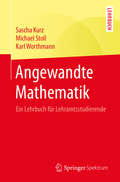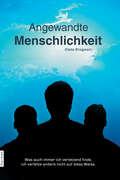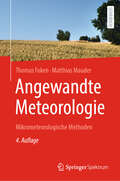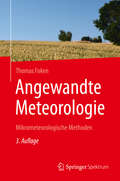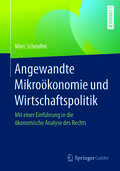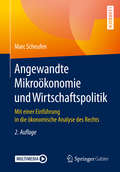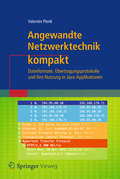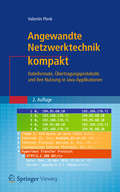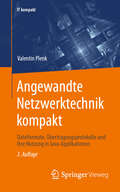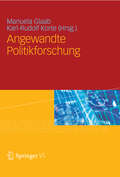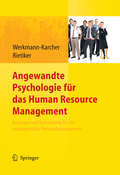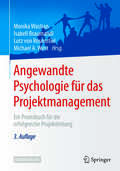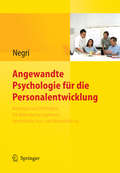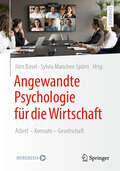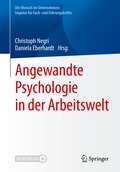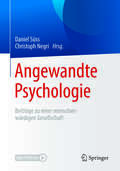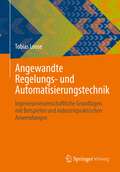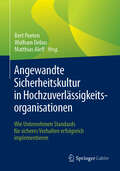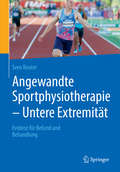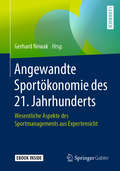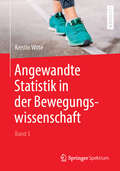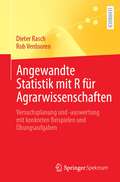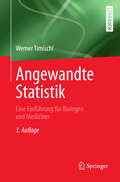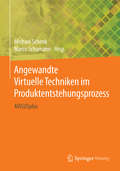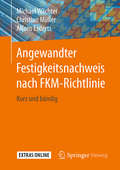- Table View
- List View
Angewandte Mathematik: Ein Lehrbuch für Lehramtsstudierende
by Sascha Kurz Michael Stoll Karl WorthmannMathematik! Aber wozu soll das bitte gut sein? Fast jede Lehrerin und jeder Lehrer wurde bereits mit dieser Frage konfrontiert. Dieses Buch macht den (Mehr-)Wert von Mathematik erfahrbar, indem Sie Algorithmen kennenlernen, mit denen Sie eine Vielzahl praktisch relevanter Probleme lösen können.Aufbauend auf Grundkenntnissen der Analysis und linearen Algebra unternehmen wir einen Streifzug durch die Angewandte Mathematik:Angefangen mit dem Lösen linearer und nichtlinearer Gleichungssysteme über die lineare Optimierung bis hin zu modernen Verfahren der Computeralgebra. So finden Sie leicht ein passendes Thema, um die Lebenswelt Ihrer Schülerinnen und Schüler aktiv mit mathematischen Methoden zu verknüpfen: Sei es, indem Sie die Bevölkerungsentwicklung basierend auf realen Daten prognostizieren oder wirtschaftliche Prozesse optimieren. Oder auch, indem Sie vermeintlich altbekannte Aufgaben wie die Multiplikation so lange kneten, bis Sie und Ihr Computer sie wirklich schnell und effizient lösen. So bekommen Sie unter anderem neue Impulse für Schwerpunktthemen oder Facharbeiten.
Angewandte Menschlichkeit
by Dada BhagwanJeder Mensch führt ein Leben, aber wieviel Menschlichkeit besitzt er? Geburt, Ausbildung, Beruf, Ehe, Kinder, Familie und am Ende... der Tod! Ist dies der Standardzyklus des Lebens, dem man folgen muss? Was ist das Endziel eines solchen Lebens? Warum werden wir geboren? Was wollen wir? Der menschliche Körper, den wir erhalten haben, sollte die Aufgabe erfüllen, menschlich zu sein. Im Leben sollte Menschlichkeit sein. Aber was ist laut Param Pujya Dadashri, dem Gnani Purush (dem Erleuchteten),Menschlichkeit? Die Definition von Menschlichkeit ist, dass es dir nicht gefällt, wenn dich jemand verletzt, dir Schwierigkeiten macht. Deshalb solltest du auch niemanden verletzen. Das ist Seiner Meinung nach die größte Menschlichkeit. Wer das versteht und im Leben anwendet, weiß, was Menschlichkeit ist. Einen menschlichen Körper zu bekommen bedeutet, dass man die Freiheit hat, in jede der vier Lebensformen (Gattis) zu gehen. Eine davon ist die menschliche Form, die anderen drei sind die tierische Form, Devgatti(Himmel/Himmlisches Wesen) und NarakGatti(Hölle/bestialische Form). Was auch immer die Ursachen sind, so sind auch die Wirkungen. Wenn wir Menschlichkeit zeigen, werden wir in der nächsten Geburt einen menschlichen Körper bekommen. Wenn wir unmenschlich sind, werden wir in der Tierform wiedergeboren. Wenn wir extrem schlecht und unmenschlich sind, werden wir in NarakGattiwiedergeboren. Wenn wir unser Leben damit verbringen, anderen Gutes zu tun, und ihnen ohne irgendwelche Erwartungen zu helfen, dann erhalten wir ein Leben in Devgatti. In diesem Buch hat Param Pujya Dadashri die Konzepte der Menschlichkeit mit der bescheidenen Absicht erörtert, damit das menschliche Leben der Menschen, wenn sie etwas über Menschlichkeit lernen,fruchtbar sein wird.
Angewandte Meteorologie: Mikrometeorologische Methoden
by Thomas Foken Matthias MauderGegenstand des Buches sind die atmosphärischen Vorgänge im unmittelbaren Lebensraum des Menschen, also in den unteren 100 –1000 Metern der Atmosphäre und in Gebieten mit nur einigen Kilometern Ausdehnung. Dieser mikrometeorologische Raum wird in Büchern der allgemeinen Meteorologie nur wenig berücksichtigt. Damit bietet das Buch Grundlagen insbesondere für angewandte meteorologische Fachgebiete wie Biometeorologie, Agrarmeteorologie, Hydrometeorologie, Umweltmeteorologie und technische Meteorologie sowie für die Biogeochemie. Ein wichtiger Schwerpunkt sind dabei die Transportprozesse und Stoffflüsse zwischen Atmosphäre und Erdoberfläche, wobei bewachsene und heterogene Unterlagen eine besondere Beachtung finden.Die Autoren behandeln die Teilgebiete Theorie, Messtechnik, experimentelle Verfahren und Modellierung so, dass sie jeweils auch eigenständig für Lehre, Forschung und Praxis genutzt werden können.Neuerungen gegenüber der dritten Auflage sind Aktualisierungen und kleinere Ergänzungen in allen Kapiteln sowie ausgewählte inhaltliche Erweiterungen unter Berücksichtigung der Fragen des Klimawandels.
Angewandte Meteorologie: Mikrometeorologische Methoden
by Thomas FokenGegenstand des Buchs sind die atmosphärischen Vorgänge im Lebensraum des Menschen. Damit liefert es die Grundlagen insbesondere für die Biometeorologie, Agrarmeteorologie, Hydrometeorologie, Umweltmeteorologie und technische Meteorologie sowie für die Biogeochemie. Der Autor behandelt Theorie, Messtechnik, experimentelle Verfahren und Modellierung so, dass die Themen jeweils für sich stehen und die Inhalte einzeln in Lehre, Forschung und Praxis genutzt werden können. Für die Neuauflage wurden das Literaturverzeichnis und einzelne Kapitel erweitert.
Angewandte Mikroökonomie und Wirtschaftspolitik: Mit einer Einführung in die ökonomische Analyse des Rechts
by Marc ScheufenDieses Buch enthält eine anwendungsorientierte Einführung in die mikroökonomische Theorie sowie deren konkrete Verwendung in der Wirtschaftspolitik, insbesondere im Kontext der ökonomischen Analyse des Rechts. Strukturell werden zunächst einzelne grundlegende ökonomische Methoden aus der Mikroökonomie vorgestellt. Didaktische Sonderfelder zu mathematischen Grundlagen sowie Beispielfälle sollen dem Leser das Erlernte veranschaulichen. Der Haupttext des Lehrbuchs verzichtet bewusst, soweit möglich, auf komplexere mathematische Konzepte, um vor allem die ökonomische Intuition sowie Zusammenhänge zwischen den Methoden aufzuzeigen. Im Anschluss an die einzelnen Kapitel werden die erlernten Methoden schließlich auf verschiedenen Bereiche des Zivilrechts – insbesondere des Immaterialgüter- (Patent-, Urheber- und Markenrecht), Wettbewerbs- und Vertragsrechts – angewendet. Auf diese Weise kann der Leser dieses Buches, die konkrete Anwendung der ökonomischen Methoden erlernen, üben und vertiefen.
Angewandte Mikroökonomie und Wirtschaftspolitik: Mit einer Einführung in die ökonomische Analyse des Rechts
by Marc ScheufenDieses Lehrbuch versteht sich als eine anwendungsorientierte Einführung in die Mikroökonomie. Neben der klassischen Methodenvermittlung stehen vor allem die Anwendung dieser Methoden auf die Wirtschaftspolitik im Allgemeinen und die ökonomische Analyse des Rechts (insbesondere Patent-, Urheber-, Wettbewerbs- und Vertragsrecht) im Besonderen im Mittelpunkt.
Angewandte Netzwerktechnik kompakt: Dateiformate, Übertragungsprotokolle und ihre Nutzung in Java-Applikationen (IT kompakt)
by Valentin PlenkDieses kompakte Lehrbuch zeigt an konkreten, in Java ausprogrammierten Beispielen, wie Information zwischen Systemen #65533;ber ein Netzwerk ausgetauscht werden kann. Dabei werden #65533;bliche Datenaustauschformate und Datenaustauschprotokolle erkl#65533;rt. Der im Buch behandelte Stoff deckt damit den gesamten Bereich technischer Kommunikation von Datenformaten #65533;ber Protokolle bis hin zum Versenden von Netzwerktelegrammen ab. Durch diese breite Themenauswahl erlangt der Leser ein Verst#65533;ndnis der typischen Probleme in der Anwendung der Netzwerktechnik, von der Repr#65533;sentation der Daten in einem Dateiformat #65533;ber den Austausch der Daten #65533;ber Standardprotokolle bis hin zur Definition einfacher, eigener Protokolle auf der Basis von TCP/IP. Der Schwerpunkt liegt dabei auf der Anwendung von Netzwerken.
Angewandte Netzwerktechnik kompakt: Dateiformate, Übertragungsprotokolle und ihre Nutzung in Java-Applikationen (IT kompakt)
by Valentin PlenkErfahren Sie mit diesem Buch alles über die angewandte NetzwerktechnikIm privaten Bereich spielt Netzwerktechnik eine eher untergeordnete Rolle. Dabei sorgt sie erst dafür, dass die Kommunikation via Internet funktioniert. Der industrielle Sektor hat die Vorteile des Datenaustauschs mit Hilfe von Netzwerken allmählich erkannt. Doch erst im Rahmen der „Industrie 4.0“ wird laut Valentin Plenk die Datenübertragung in Echtzeit mehr Bedeutung gewinnen. Mit Blick auf diese Entwicklung stellt er in seinem Buch im Sinne der angewandten Netzwerktechnik speziell die höheren Schichten der Netzwerktechnik in den Fokus. Dieses kompakte Lehrbuch zeigt Ihnen anhand von konkreten, in Java ausprogrammierten Beispielen, wie Informationen zwischen Systemen über ein Netzwerk ausgetauscht werden können. Pro Kapitel behandelt dieses Netzwerktechnik-Buch ein bestimmtes Thema. Nach der Einführung in die Grundlagen der Kommunikation geht der Autor zunächst auf Java-Streams, Zeichencodierung sowie die Netzwerkanalyse mit Wireshark ein. Anschließend schenkt Plenk speziell folgenden Datenaustauschformaten sowie Protokollen besonderes Augenmerk:• JSON• HTML• HTTP• OPC UA• TCP/IP• UDP/IPKonkrete Beispiele und Übungen geben Ihnen PraxiseinblickeAuf diese Weise deckt dieses Buch über die angewandte Netzwerktechnik den gesamten Bereich technischer Kommunikation ab, von den Netzwerkprotokollen bis hin zum Versenden von Netzwerktelegrammen. Durch diese breite Themenauswahl bekommen Sie als Leser ein tieferes Verständnis für die typischen Problemstellungen in der Anwendung der Netzwerktechnik. Sie erfahren mehr über die Darstellung von Daten in einem bestimmten Dateiformat und wie Sie Daten mittels Standardprotokollen austauschen können. Zudem lernen Sie, wie Sie eigene, einfache Protokolle auf der Basis von TCP/IP erstellen können. Schwerpunkt des Buches bildet dabei immer die Anwendung von Netzwerken.Mit Hilfe zahlreicher Übungsaufgaben (inklusive Lösungsvorschlägen) sowie Anwendungsbeispielen können Sie Ihren persönlichen Kenntnisstand überprüfen und das Gelernte vertiefen. So sind Sie ideal auf die Praxis vorbereitet. Die zweite Auflage des Buchs „Angewandte Netzwerktechnik kompakt“ wurde um den Themenbereich Webservices ergänzt. Im Abschnitt zu UDP/IP finden Sie jetzt außerdem hilfreiche Codebeispiele für Broadcast und Multicast.
Angewandte Netzwerktechnik kompakt: Dateiformate, Übertragungsprotokolle und ihre Nutzung in Java-Applikationen (IT kompakt)
by Valentin PlenkErfahren Sie mit diesem Buch alles über die angewandte NetzwerktechnikIm privaten Bereich spielt Netzwerktechnik eine eher untergeordnete Rolle. Dabei sorgt sie erst dafür, dass die Kommunikation via Internet funktioniert. Der industrielle Sektor hat die Vorteile des Datenaustauschs mit Hilfe von Netzwerken allmählich erkannt. Doch erst im Rahmen der „Industrie 4.0“ wird laut Valentin Plenk die Datenübertragung in Echtzeit mehr Bedeutung gewinnen. Mit Blick auf diese Entwicklung stellt er in seinem Buch im Sinne der angewandten Netzwerktechnik speziell die höheren Schichten der Netzwerktechnik in den Fokus. Dieses kompakte Lehrbuch zeigt Ihnen anhand von konkreten, in Java ausprogrammierten Beispielen, wie Informationen zwischen Systemen über ein Netzwerk ausgetauscht werden können. Pro Kapitel behandelt dieses Netzwerktechnik-Buch ein bestimmtes Thema. Nach der Einführung in die Grundlagen der Kommunikation geht derAutor zunächst auf Java-Streams, Zeichencodierung sowie die Netzwerkanalyse mit Wireshark ein. Anschließend schenkt Plenk speziell folgenden Datenaustauschformaten sowie Protokollen besonderes Augenmerk:• JSON• HTML• HTTP• OPC UA• TCP/IP• UDP/IPKonkrete Beispiele und Übungen geben Ihnen PraxiseinblickeAuf diese Weise deckt dieses Buch über die angewandte Netzwerktechnik den gesamten Bereich technischer Kommunikation ab, von den Netzwerkprotokollen bis hin zum Versenden von Netzwerktelegrammen. Durch diese breite Themenauswahl bekommen Sie als Leser ein tieferes Verständnis für die typischen Problemstellungen in der Anwendung der Netzwerktechnik. Sie erfahren mehr über die Darstellung von Daten in einem bestimmten Dateiformat und wie Sie Daten mittels Standardprotokollen austauschen können. Zudem lernen Sie, wie Sie eigene, einfache Protokolle auf der Basis von TCP/IP erstellen können. Schwerpunkt des Buches bildet dabei immer die Anwendung von Netzwerken.Mit Hilfe zahlreicher Übungsaufgaben (inklusive Lösungsvorschlägen) sowie Anwendungsbeispielen können Sie Ihren persönlichen Kenntnisstand überprüfen und das Gelernte vertiefen. So sind Sie ideal auf die Praxis vorbereitet. Die zweite Auflage des Buchs „Angewandte Netzwerktechnik kompakt“ wurde um den Themenbereich Webservices ergänzt. Im Abschnitt zu UDP/IP finden Sie jetzt außerdem hilfreiche Codebeispiele für Broadcast und Multicast.
Angewandte Politikforschung: Eine Festschrift für Prof. Dr. Dr. h.c. Werner Weidenfeld
by Manuela Glaab Karl-Rudolf KortePolitische Akteure sind auf kompetente Politikberatung angewiesen. Was ist der Stand der angewandten Politikforschung in Deutschland? Welche Forschungsstränge und konkreten Praxisanwendungen lassen sich aufzeigen? Welchen Beitrag kann wissenschaftliche Politikberatung zur Rationalität von politischen Entscheidungen leisten? Der Konzeptband versammelt theoretische und konzeptionelle Grundlagen, stellt Strukturen, Akteure, Ressourcen vor und bietet außerdem empirische Analysen und Anwendungsbeispiele. Angewandte Politikforschung erhält so Konturen einer eigenständigen politikwissenschaftlichen Forschungsperspektive. Beiträge von Manuela Glaab, Karl-Rudolf Korte, Andreas Blätte, Warnfried Dettling, Manuel Fröhlich, Heinz-Jürgen Axt, Josef Janning, Jürgen Turek, Markus Hoffmann, Marion Steinkamp, Tassilo Wanner, Daniel von Hoyer, Otto Schmuck, Melanie Piepenschneider, Thomas Leif, Jürgen Gros, Andreas Kießling, Peter Frey, Michael Garthe, Christian Jung, Matthias Belafi, Franco Algieri, Janis A. Emmanouilidis, Florian Baumann, Reinhardt Rummel, Michael Bauer, Almut Möller, Uwe Wagschal, Gerd Langguth, Lars Colschen, Andreas Meusch, Martin Brusis, Olaf Hillenbrand, Peter Thiery, Silvia Simbeck, Susanne Ulrich, Florian Wenzel, Eva Feldmann-Wojtachnia, Barbara Tham, Britta Schellenberg, Michael Weigl .
Angewandte Psychologie für das Human Resource Management. Konzepte und Instrumente für ein wirkungsvolles Personalmanagement: Konzepte Und Instrumente Für Ein Wirkungsvolles Personalmanagement
by Birgit Werkmann-Karcher Jack RietikerAuch wenn Personalmanager keine Psychologen sein müssen, was sie tun, ist angewandte Psychologie: u. a. Menschen und ihre Rollen im Unternehmen verstehen und beeinflussen, Wandel in Organisationen gestalten. Dafür kann die Kenntnis psychologischer Instrumente und Theorien sehr hilfreich sein. Dieser Leitfaden basiert auf einer Weiterbildung für Personalmanager am Institut für Angewandte Psychologie (Zürich) und beleuchtet aktuelle Themen wie z. B. Talent-, Performance- und Demografie-Mangement - mit zahlreichen Tipps, Checklisten und Fallbeispielen.
Angewandte Psychologie für das Projektmanagement: Ein Praxisbuch für die erfolgreiche Projektleitung
by Michael A. West Monika Wastian Isabell Braumandl Lutz Von RosenstielProjektmanagement ist mehr als nur planen und organisieren: Personen führen, mit Konflikten und Krisen umgehen, kommunizieren, Meinungsbildung und Projektumfeld steuern, die Identifikation der Mitarbeiter fördern, Wissen und Kreativität managen. Worauf es dabei ankommt, erklären in dem Handbuch erfahrene Psychologen und Experten aus der Projektmanagement-Praxis: Ausgehend von typischen Problemen aus dem Projektalltag werden psychologische Hintergründe erläutert und Lösungen präsentiert. Mit Tipps zum Selbstmanagement, Fallbeispielen und Checklisten.
Angewandte Psychologie für die Personalentwicklung. Konzepte und Methoden für Bildungsmanagement, betriebliche Aus- und Weiterbildung: Konzepte Und Methoden Für Bildungsmanagement, Betriebliche Aus- Und Weiterbildung
by Christoph NegriIn Zeiten rasanter Veränderungen in Organisationen und der Wirtschaft insgesamt sind auch Bildungsfachleute und Personalentwickler gefordert, ihre Kernaufgaben neu zu definieren. Dazu bietet die angewandte Psychologie einen Orientierungsrahmen. In dem Band vermitteln Praktiker die psychologischen Grundlagen für eine moderne, nachhaltige betriebliche Bildungsarbeit und Personalentwicklung. Dabei greifen sie auch aktuelle Themen wie E-Learning, erlebnisorientiertes Lernen, Bildungsmarketing, Performance Management oder Corporate Learning auf.
Angewandte Psychologie für die Wirtschaft: Arbeit – Konsum – Gesellschaft
by Jörn Basel Sylvia Manchen SpörriLehrbuch zur angewandten Psychologie in der Wirtschaft mit den Schwerpunkten Arbeit, Konsum und Gesellschaft Wirtschaft und Gesellschaft werden durch Megatrends wie digitale Transformation, nachhaltige Entwicklung, demografischen Wandel und weltweite Krisen herausgefordert. Dieses wirtschaftspsychologische Lehrbuch stellt den Menschen in den Mittelpunkt dieser Dynamik und bietet einen anwendungsbezogenen Einblick in die drei zentralen Bereiche: 1.) Arbeit und Organisation 2.) Konsum und Markt sowie 3.) Kapital und Gesellschaft Klar strukturiert und didaktisch ansprechend bietet es einen gut verständlichen und praxisorientierten Überblick zu wirtschaftspsychologischen Themen wie: Generationen-übergreifendes Management, Freiwilligenarbeit, Zukunft der Arbeit und künstliche Intelligenz, New Work, digitale Transformation, Führung von virtuellen und hybriden Teams, Führung und Nachhaltigkeit, Future Skills undMythen der Personalauswahl Konsumentenverhalten im Mehrkanalhandel, Kundenvertrauen und Misstrauen, Nachhaltiger Konsum, User und Customer Experience, nachhaltiges Mobilitätsverhalten Gestaltung von Anreizsystemen und Experimentability, Corporate Social Responsibility, das Verhältnis von Gemeinsinn und Eigennutz, verhaltensorientierte Wirtschaftsethik Dazu erhalten Sie digitale Zusatzmaterialien. Zu den Zielgruppen: Studierende der Wirtschaftspsychologie und anderer Studiengänge im Bereich Wirtschaft, Teilnehmende von Weiterbildungen, Entscheidungsträger, Führungskräfte und alle, die sich für aktuelle Herausforderungen für Wirtschaft und Gesellschaft interessieren. Zu den Herausgebern: Prof. Dr. Jörn Basel, Professor für Wirtschaftspsychologie an der Hochschule Luzern (HSLU). Mitglied des First International Network on Trust (FINT). Seine Forschung beschäftigt sich unter anderem damit, wie Organisationen verlorenes Vertrauen wiederaufbauen können und wie erfolgreiche Verhandlungen gelingen können. Prof. Dr. Sylvia Manchen Spörri, Professorin für Wirtschaftspsychologie an der Hochschule Luzern (HSLU). Mitglied der Schweizerischen Gesellschaft für Arbeits- und Organisationspsychologie. Mitbegründerin des Bachelorstudiengangs Business Psychology, Forschung im Bereich Führung, Diversity und Nachhaltigkeit, Mentorin und Coach.
Angewandte Psychologie in der Arbeitswelt (Der Mensch im Unternehmen: Impulse für Fach- und Führungskräfte)
by Daniela Eberhardt Christoph NegriDieser Band bietet einen brillanten und gut gewählten Mix, eine Art "Best-off-Zusammenstellung" zu den vielfältigen Themen des IAP Impuls aus der Breite und Vielfalt der Angewandten Psychologie.Sie erhalten somit aktuelles, kompaktes Wissen und interessante und konkrete Praxisbeispiele zu den folgenden, in der Arbeitswelt 4.0 sehr wichtigen und relevanten Themenbereichen:Führung in der Arbeitswelt 4.0TeamarbeitUnternehmertumChange-ManagementDiversityDigitalisierung, KI Zielgruppen: Fach- und Führungskräfte, Geschäftsführer/-innen, Personalentwickler/-innen, HR-Manager/-innen, Berater/-innen und alle an den Entwicklungen der Arbeitswelt 4.0 interessierten Personen.Zu den Herausgebern: Prof. Dr. Christoph Negri ist Leiter des IAP Institut für Angewandte Psychologie an der ZHAW Zürcher Hochschule für Angewandte Wissenschaften. Seit 2015 führt er am IAP verstärkt neue Entwicklungen im Bereich Lernen und Lehren ein und treibt den digitalen Wandel in Weiterbildung und Dienstleistung voran.Prof. Dr. Daniela Eberhardt ist Direktorin Human Resources Management der Stadt Zürich und war davor langjährige Leiterin des IAP Institut für Angewandte Psychologie an der ZHAW Zürcher Hochschule für Angewandte Wissenschaften.
Angewandte Psychologie: Beiträge zu einer menschenwürdigen Gesellschaft (Der\mensch Im Unternehmen: Impulse Für Fach- Und Führungskräfte Ser.)
by Christoph Negri Daniel SüssDieses aktuelle und zukunftsweisende Fachbuch zeigt aus einer Perspektive der humanistischen und positiven Psychologie auf, welche Beiträge die Angewandte Psychologie zu einer humanen und nachhaltigen Gesellschaft leisten kann. Denn menschenwürdig ist eine Gesellschaft dann, wenn Menschen darin aufblühen können, Organisationen und Institutionen immer auch dem Gemeinwohl dienen und die natürlichen Ressourcen nachhaltig gepflegt werden. Gleichzeitig dient dieses Werk als Festschrift zum 60. Geburtstag von Prof. Dr. Christoph Steinebach. Zielgruppen: Professionals und an dieser Thematik interessierte Laien. Zu den Herausgebern: Prof. Dr. Daniel Süss ist Leiter des Psychologischen Instituts, und Prof. Dr. Christoph Negri ist Leiter des IAP Institut für Angewandte Psychologie an der ZHAW - Zürcher Hochschule für Angewandte Wissenschaften.
Angewandte Regelungs- und Automatisierungstechnik: Ingenieurwissenschaftliche Grundlagen mit Beispielen und industriepraktischen Anwendungen
by Tobias LooseIn dem vorliegenden Buch werden ingenieurwissenschaftliche, regelungstechnische Grundlagen vermittelt, die auf typische Industriebeispiele angewandt werden, wie z.B. Werkzeugmaschinen oder Transportsysteme. Mit Hilfe mathematischer Modellbildung wird aufgezeigt, wie Regler eingestellt werden können und wie Systeme optimiert werden können. Darin wird insbesondere dargestellt, wie bereits in der Projektierungs- und Konstruktionsphase von Anlagen Maßnahmen ergriffen werden können, damit das geregelte Gesamtsystem optimiert wird.
Angewandte Sicherheitskultur in Hochzuverlässigkeitsorganisationen: Wie Unternehmen Standards für sicheres Verhalten erfolgreich implementieren
by Bert Poeten Wolfram Debus Matthias AleffSicherheit ist in Hochzuverlässigkeitsorganisationen unabdingbar. Ein wesentlicher Beitrag des Personals zur Sicherheit besteht darin, Fehler möglichst zu vermeiden. Aber Menschen machen Fehler. Es muss daher das Ziel sein, Fehler zu minimieren und einen adäquaten Umgang mit Fehlern zu praktizieren. Der erste Schritt dazu ist, die Verhaltensweisen zu definieren, die vom Personal erwartet werden. Durch standardisiertes sicheres Verhalten kann die Fehlerquote signifikant verringert und so die Sicherheitskultur in Unternehmen deutlich verbessert werden. Dieses Buch beleuchtet - zunächst am Beispiel der Kernenergie -, welche Verhaltensweisen zur Erhöhung der Sicherheitskultur beitragen, wie man diese Verhaltensstandards an andere Branchen anpasst und erfolgreich in Unternehmen implementiert. Erfahrene Praktiker aus Luftfahrt, Polizei, Gesundheitswesen und Energieversorgung teilen eigene Erfahrungen und wertvolle Praxisbeispiele. Aus dem Inhalt Fehler-, Sicherheits- und Feedbackkultur Angewandte Sicherheitskultur durch Verhaltensstandards Werkzeuge des professionellen Handelns Sicherheitskultur in ausgewählten Branchen Die HerausgeberDipl.-Ing. Bert Poeten, Dipl.-Phys. Wolfram Debus und Dr. rer. medic. Matthias Aleff beraten Unternehmen zur systematischen Optimierung ihrer Sicherheitskultur. Alle drei kommen aus dem Kernenergie-Sektor und sind Experten darin, sicherheitsgerichtete Verhaltensstandards auf hohem Niveau zu entwickeln und zu implementieren.
Angewandte Sportphysiotherapie - Untere Extremität: Evidenz für Befund und Behandlung
by Sven ReuterDieses Praxisbuch liefert Physiotherapeuten, Sportwissenschaftlern und Sportmedizinern einen zuverlässigen Leitfaden für Befund und Behandlung von Verletzungen bei Freizeit- und Profisportlern. Aktuelle Studien und Wirksamkeitsanalysen geben eine konkrete Richtlinie für die Förderung von komplexen Heilungsprozessen, wie z.B. die spezielle Diagnostik des femoroacetabulären Impingements, des patellofemoralen Schmerzsyndroms oder der plantaren Fasziopathie. Die Häufigkeit der wichtigsten Verletzungsmuster ist in übersichtlichen Tabellen zusammengefasst. Aus dem Inhalt: Kriterien für den Übergang in die höhere RehabilitationsstufeLimitationen bei der MobilisationVorgaben zum angepassten KrafttrainingBesonderheiten für neuromuskuläres Training und im Alltag Plus: Tabellen zum Nachbehandlungsschema für jedes Krankheitsbild!
Angewandte Sportökonomie des 21. Jahrhunderts: Wesentliche Aspekte des Sportmanagements aus Expertensicht
by Gerhard NowakDieses Lehrbuch vermittelt einen komprimierten Überblick über praxisbezogene Themen des Sportmanagements mit wissenschaftlichem Hintergrund. Besonders anschaulich werden hierbei theoretische Grundlagen des Sportmanagements mit konkreten Fallbeispielen aus der Sportpraxis in Form von Audio- und Video-Podcasts verknüpft.In drei thematischen Blöcken befassen sich die Autoren zunächst mit grundsätzlichen Fragen der Wertschöpfung, des Marketings sowie des Managements von Sportorganisationen.Im zweiten Themenblock stehen wesentliche Aspekte der Vermarktung im Profisport im Mittelpunkt: Medien- und Namensrechte und deren wirtschaftliche Bedeutung, Sponsoring, die Nutzung von Merchandising-Artikeln sowie der Handel für Sportausrüstung. Der dritte Teil schließlich widmet sich kommunikationspolitischen Themen. Dabei werden sowohl die klassischen als auch die modernen Medien, z.B. in Form von Social-Media, betrachtet. Ein Beitrag geht speziell auf die Chancen und Risiken der digitalen Transformation für den Breitensport ein, ein abschließender Beitrag widmet sich dem Sportevent-Management.
Angewandte Statistik in der Bewegungswissenschaft (Band 3)
by Kerstin WitteDieses Buch soll Studierende als auch Doktoranden motivieren, eigene Studien mit dem richtigen Untersuchungsdesign zu planen und durchzuführen.Für viele bewegungswissenschaftliche Untersuchungen müssen statistische Verfahren angewendet werden. Doch oft fällt es den Studierenden schwer, das jeweils geeignete Verfahren zu finden. Dieser Band soll helfen, insbesondere Studierenden der Sportwissenschaft zu helfen, die statistischen Grundlagen zu verstehen. Dabei unterstützt eine Vielzahl von Übersichten über die Verfahren und Abbildungen ihre Wirkungsweise. Viele sportmotorische Beispiele werden erläutert, um die Anwendbarkeit und den Praxisbezug zu demonstrieren. Zu den vertiefenden Aufgaben gibt es auch einen Abschnitt mit Hinweisen zur Lösung der in Band 2 gestellten empirischen Aufgaben.Auf folgende Themenschwerpunkte wird besonders eingegangen: empirische Forschungsmethoden, deskriptive Statistik, Wahrscheinlichkeitstheorie, Parameterschätzung, Aufstellen und Prüfen von Hypothesen, Verfahren zum Testen von Unterschieds- und Zusammenhangshypothesen, Varianzanalyse, Faktorenanalyse, Testtheorie und Zeitreihenanalyse.
Angewandte Statistik mit R für Agrarwissenschaften: Versuchsplanung und -auswertung mit konkreten Beispielen und Übungsaufgaben
by Dieter Rasch Rob VerdoorenDieses Buch führt in die angewandte Statistik für Agrarwissenschaften ein und unterstützt bei der Forschung in der Pflanzen- und Tierproduktion und im Feldversuchswesen. Es nutzt ausgiebig das frei verfügbare Programmpaket R: Über das gesamte Buch hinweg werden im Rahmen umfangreicher Beispiele passende R-Programmcodes angegeben und erläutert. Die Codes können mit eigenen Daten kombiniert und so zur Planung und Auswertung eigener Versuche verwendet werden. So können etwa Wachstumsfunktionen angepasst, Varianzanalysen berechnet oder optimale Versuchspläne und minimale Stichprobenumfänge gefunden werden und vieles mehr. Eine Installationsbeschreibung für R wird ebenfalls zur Verfügung gestellt. Zahlreiche Übungsaufgaben mit Lösungen ergänzen das Buch, so dass es als Lehr- und Nachschlagewerk nutzbar ist. Besonders hervorzuheben ist, dass auch balancierte unvollständige Blockanlagen (BUB) erläutert werden und erstmalig eine vollständige Liste kleinster (mit möglichst geringer Anzahl von Blocks) BUB für bis zu v = 25 Behandlungen und Blockgrößen ≤ v/2 im Netz zur Verfügung gestellt wird. Für Sortenversuche sind die BUB allerdings oft nicht nutzbar, weil sie zu viele Wiederholungen erfordern. Dafür haben sich „verallgemeinerte Gitter“ oder alpha-Anlagen bewährt, die ebenfalls behandelt werden.
Angewandte Statistik: Eine Einführung für Biologen und Mediziner
by Werner TimischlDie "Angewandte Statistik" ist ein Lehr- und Übungsbuch für Anwenderinnen und Anwender der Statistik, die ein Verständnis für statistische Methoden und eine Sicherheit in der Anwendung dieser Methoden erwerben wollen. Vorausgesetzt wird nur die Kenntnis der für den Universtäts- oder Fachhochschulzugang erforderlichen Schulmathematik. Das Lehrbuch führt zuerst in die Wahrscheinlichkeitsrechnung ein und stellt grundlegende Wahrscheinlichkeitsverteilungen vor. Ausführlich werden die Parameterschätzung und das Testen von Hypothesen behandelt. Mit den gängigen Korrelationsmaßen und ausgewählten Regressionsmodellen wird die statistische Grundbildung abgerundet. Die Kapitel über varianzanalytische Modelle und multivariate Verfahren geben einen Einblick in zwei weitere, für die statistische Praxis relevante Gebiete. Darüber hinaus werden Vertiefungen und spezielle Anwendungen in ergänzenden Abschnitten bereitgestellt. Zahlreiche, vollständig durchgerechnete Beispiele und Übungsaufgaben mit einem ausführlichen Lösungsteil machen die "Angewandte Statistik" zu einem Arbeitsbuch, das sich auch zum Selbststudium eignet. Die Ausrichtung auf die Statistik-Software R (durch Verweise auf die entsprechenden R-Funktionen und die Angabe des R-Codes bei den Lösungen der Aufgaben) trägt der Bedeutung computerunterstützter Problemlösungen in der statistischen Praxis Rechnung.
Angewandte Virtuelle Techniken im Produktentstehungsprozess: AVILUSplus
by Michael Schenk Marco SchumannDieses Buch beschreibt die Forschungsergebnisse des Projektes AVILUSplus. Die Wissenschaftler befassen sich mit den Technologieentwicklungen zur Erh#65533;hung der Realit#65533;tsn#65533;he virtueller Modelle. Dazu werden f#65533;nf Themenschwerpunkte betrachtet: Informationsmanagement im Produktlebenszyklus, Simulation und Rendering, Tracking, Interaktion und Geometrieerfassung. Das Buch richtet sich an Wissenschaftler und Technologieentwickler, die sich #65533;ber den aktuellen Stand, Entwicklungstrends und Einsatzm#65533;glichkeiten virtueller Techniken informieren m#65533;chten. Umfangreiche Referenzen liefern einen Ausblick auf weiterf#65533;hrende Arbeiten.
Angewandter Festigkeitsnachweis nach FKM-Richtlinie: Kurz und bündig
by Christian Müller Michael Wächter Alfons EsdertsDieses Fachbuch unterst#65533;tzt nachhaltig bei der Durchf#65533;hrung von rechnerischen Festigkeitsnachweisen mit der FKM-Richtlinie ,,Rechnerischer Festigkeitsnachweis". Es behandelt den Festigkeitsnachweis mit einigen Einschr#65533;nkungen, die jedoch f#65533;r viele Anwendungsf#65533;lle ausreichend sind und reduziert damit den Umfang der Richtlinie auf die wesentlichen Aspekte. Der prinzipielle Ablauf eines Festigkeitsnachweises wird anhand von praxisrelevanten Beispielen erl#65533;utert, die vom Leser parallel nachvollzogen werden k#65533;nnen. Bei den Beispielen bildet die Ermittlung der #65533;rtlichen elastizit#65533;tstheoretischen Spannungen mit der Software ANSYS Workbench einen #65533;ber die Richtlinie hinausgehenden Bestandteil. Auf der Verlagsseite im Internet finden sich CAD- und FE-Modelle f#65533;r die Beispiele sowie weitere Zusatzinformationen wie Berechnungsskripte f#65533;r die lineare Schadensakkumulation nach dem Verfahren Miner konsequent.
